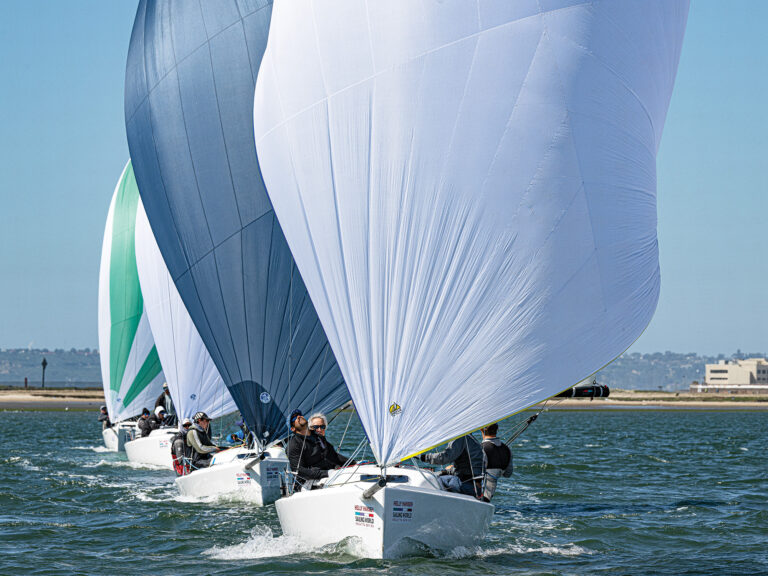
Ben Ainslie was quite clear when I saw him in the Land Rover BAR headquarters in Portsmouth recently: “We are not quite fully up and running, but we have the key elements of the team in place.”
As one would expect, he added, the team have made key changes and consider themselves well ahead of where they were at this time in the AC35 Cup cycle. “We are much more focused as to what is important to be a successful team on the water and in the design,” he added. “While we are comfortable in our sponsorship position at this stage, we are still not fully covered financially, nor can we expect to be when we don’t know the full extent of the costs, nor will we be until we know the Rules for the boat and the regatta program we are expected to keep.”
Financially, it would however appear sound. BAR’s board of investors, he says, have agreed to underwrite the team to a significant amount again – roughly 70 percent of its budget. “It’s not to liken it to a billionaire’s budget,” he says. “We don’t have an open checkbook. We are going to have to run to a tight budget.”
Which is why perhaps that one of Ben’s first personnel acquisitions was Grant Simmer, well known after five years in the Cup for being, amongst his other attributes, as having a stranglehold on the finances. Simmer joined BAR as CEO and there was some inevitability about this move, as Grant relates: “Ben was just harassing me about joining, and basically I still wanted to be part of the Cup. The main reason was that I enjoy being in a young team, and I enjoy their technology and the challenge, but also Ben wanted a hand and we are pretty good mates, and I said OK.”
Simmer has four Cup wins behind him, and one of his driving forces is that he wishes to match the five wins of his mate, Murray Jones. He is unlikely to rest until he does. Thus, his motivation as CEO is to give Land Rover BAR the very best “tools” for that purpose. At this stage it is the recruitment of suitable talent to provide the technical know-how and that means those who have succeeded in the recent past – talent that knows and understands the problems associated with foiling.
These will be deep, as the 75-footer, which will be raced, is vastly different from the AC50 used on the Great Sound in Bermuda. In the words of Land Rover BAR’s new Head of Design, Nick Holroyd: “One of the things to be careful with here is not to fall into the trap of fighting yesterday’s war.”
“The power consumption, and the mechanics of the catamaran are one thing,” adds Holroyd, “and this boat will be different. We need to look at this class rule very carefully when it comes out [late March]. You need to look at the boat and sit down with the sailing team in the right way and you can’t have people predicting their jobs, or their roles or anything like that. You need to look at how are we going to sail this boat. What is the most efficient way of sailing this boat?”
The process has moved away from naval architects, structural and mechanical engineers; the process is of a multi-disciplinary nature and Holroyd appreciates this, saying: “One of the great things about this team is the technical partners that it brings in. If you are talking automation and control and what have you, you’re able to go and talk to the guys that are putting the assembly lines together for Jaguar Land Rover, for example, and to talk control theory with those guys is some of the unique opportunities that working in the UK really brings to me.”
The real truth will be discovered when the AC75s emerge. Andy Claughton, who was technical director for Emirates Team New Zealand in AC34 and BAR in AC35, and is now wandering loose, points out that, unlike a multihull, there is no reserve buoyancy to windward when the breeze drops and ride-height control is lost.
Holroyd counters the concern by saying: “You pay a drag penalty for designing stability into the foil, and where ETNZ was able to leverage an advantage was by looking at the way the boat was sailed and how you control a foil that is a lot less stable. To do that you need more power and they had more people that had their hands free to run the controls – thanks to the pedaling system of the cyclors. So the feedback led them to designing a fast foil was making sure they had the complete set of other systems around to support what was probably an unsailable foil with systems that weren’t optimized to look after that design.”
It can only be hoped that each team can find the way to deal with increased lift and lack of stability. This time there will not be manual power to provide the necessary reserve in the hydraulics, it would be too much for that and so a motor will be on the boat, presumably the same one-design motor, to provide the control.
Nothing further can be finalized in the BAR camp until the Rule emerges at the end of March and there is no doubt Luna Rossa, the Challenger of Record, will have had a large influence. ETNZ’s Grant Dalton has indicated that the Rule will be delivered on time, which will give Emirates Team New Zealand more time to settle other pressing issue of AC36, namely berthing details of the challengers, which are currently in dispute with the City authorities, and the potential finance by the New Zealand Government.









